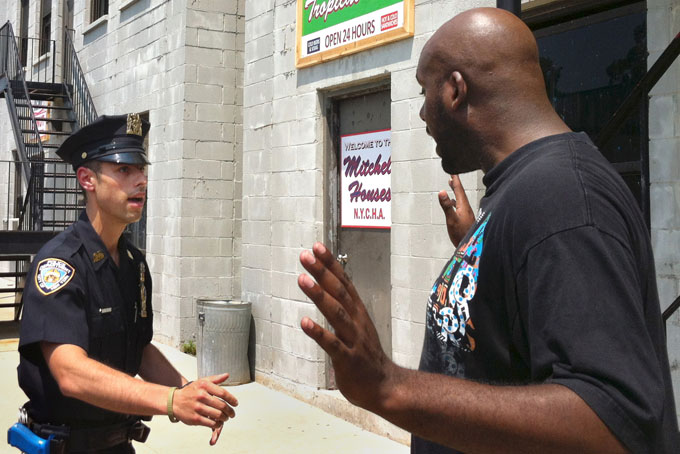
NYPD TRAINING–Det. Anthony Mannuzza, left, and Police Officer Robert Martin, right, simulate a street stop during a training session at the New York Police Department’s training facility in Rodman’s Neck, in the Queens borough of New York, as the NYPD was re-training thousands of officers on how to do street stops amid a wave of criticism about the department’s controversial stop, question and frisk policy. (AP Photo/Colleen Long, File)by
Colleen Long
NEW YORK (AP) — After Officer Pedro Serrano decided to testify in federal court about what he sees as wrongdoing within the New York Police Department, a rat sticker appeared on his locker.
That was the least of his problems.
Serrano claims he’s been harassed, micromanaged and eventually transferred to a different precinct and put on the overnight shift.
“It hasn’t been a picnic,” he said in an interview this week. “They have their methods of dealing with someone like me.”
Serrano and other whistle-blowers took the stand in a civil rights case challenging some of the 5 million streets stops made by police in the past decade using a tactic known as stop and frisk. They believe illegal quotas are behind some wrongful stops of black and Hispanic men.
“A lot of people told me not to come forward because of what would happen — they said the department would come after me,” Serrano said. “But I’ve been thinking about it since 2007. I felt I couldn’t keep quiet.”
Several other officers and police brass testified to the opposite: They say there are no quotas. Most officers follow the letter of the law, and low-performing cops like Serrano are lazy malcontents who make the city less safe.
Under NYPD policy, officers are required to report corruption without fear of retribution to the internal affairs bureau, which investigates the claims.
But starting with legendary whistle-blower Frank Serpico in the 1970s, corruption scandals large and small have exposed a clannish culture that critics say encourages police officers to turn a blind eye to wrongdoing and never question authority — or else face harassment by peers and punishment by superiors.
As a plainclothes officer, Serpico was labeled a traitor for refusing payoffs and reporting corruption. On Feb. 3, 1971, he was shot in the face during a drug raid; he says other officers purposely failed to back him up. He recovered and testified before the Knapp Commission — a story etched in popular culture by a hit movie starring Al Pacino.
In the early 1990s, an internal affairs investigator who pursued drug-dealing officers was blackballed by his commanders before an independent investigation by the Mollen Commission proved him right. And the 1997 police assault of Abner Louima resulted in charges against officers who kept quiet because of a so-called blue wall of silence — an unspoken code among the rank-and-file to never “rat” on each other.